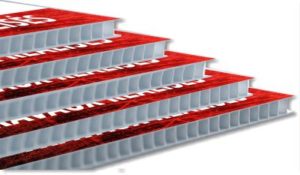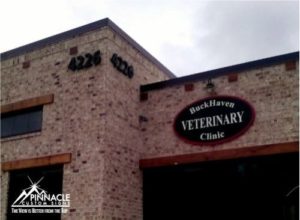Many building graphics are meant to last one year, but often stay up far longer. One of the biggest challenges for both the sign maker and the customer is to communicate is the lifetime a sign is expect to be used and will actually be used.
As the consumer, you want to be able to get the longest use possible out of your investment. As the producer of the sign, we want to be able to provide you with what you are looking for based on your expectations.
The perfect harmony of these two things all boil down to communication of whether your sign is a temporary vs. permanent signage solution for your business.

There are three particular time periods that require careful management of temporary and permanent solution decisions:
Up to One Year: Most temporary solutions might be needed for a few weeks, but more often are in place for six months to a year. While these can be handled by direct to substrate and vinyl graphics there is a considerable difference in durability between material and inks. In addition, small decisions like placing graphics inside windows can yield enormous changes in the longevity of your signage.
One-to Five Years: During this time period the environment starts taking a toll on even the most durable materials. Many companies have a five-year guarantee, but these are often voided by specific environmental conditions including pollution and exposure to sunlight. Choosing the right sign and graphic company becomes much more important at this stage of the project since the use of additional coating and laminates can play a major role in longevity.
More than Five Years: After five years, even the most durable graphic methods begin to break down. Most embedded solutions, from dye sublimation to powder coated graphics, are built to withstand long outdoor periods. But even these solutions require careful preparation and placement if meant to survive in difficult environments.
Temporary vs. Permanent – Choosing the Right Material for the Job
A material in sign making refers to the physical surface where the ink is applied and can be changed based on the needed longevity. Here are some of the material options for choice:

Corrugated Plastic / coro– Often referred to in the industry as “Coro,” this material is predominately used for temporary and promotional signage. It’s ideal for lawn signs such as election signs, sales and contractor signs, directional signage, real estate signs, or site signs for new building projects.
PVC Smooth Plastic – A PVC “Foam” that is lightweight yet rigid and durable, it is ideal for medium-term signs for use both indoors and outdoors. It’s commonly used for menu boards, point of purchase, and trade-show directional signs.
Polystyrene / Styrene -High Impact Polystyrene (HIPS) offers a consistent, easily printed, smooth, matte surface for either one or two-sided printing applications. This polystyrene product, available in 4×8 sheet form in three thicknesses, is especially suitable for digital printing of displays, POP graphics, signs, tags and cards. It can also be contour cut.
Foamcore & Gator Foam / Gator Plast- This refers to a soft, inexpensive paper product with a wood-fiber veneer. GATORPLAST is an extruded, rigid, lightweight polystyrene foam board bonded between two layers of ultra-thin polystyrene veneer. These are typically used for medium term office displays, kiosks, POP, exhibits, custom shaped signs, easel signs, and temporary signs.
Acrylic & Plexiglass– These are versatile surfaces used for a large variety of applications. Available in multiple translucence levels and thicknesses, they’re perfect for modern lobby displays, backlit signs of all types, 3D lettering, and more. Acrylic and Plexiglass are used frequently in health clubs & offices.
Lexan / Polycarbonate– Lexan / Polycarbonate comes in translucent white or clear for use in sign faces onbacklit signs. It is 3/16″ thick and can be cut to many sizes up to 100″ by length of sign.
Aluminum Composite Material– Aluminum composite material is made of two sheets of thin aluminum with a solid polyethylene plastic core. This material is ideal for mid-to-long term outdoor signs as it is not prone to warping in high heat, and moisture will not affect is like it does wood. It’s great for use in post & rail signs or wall signs.

MDO Wood– MDO has an exterior-use, long-term grade plywood core, with a moisture-proof smooth surface. Plastic edge cap is optional. It’s perfect for construction site signs, real-estate signs, billboards, double post signs and more.
FRP Fiberboard– Fiberglass Reinforced Plywood Fiberboard can be used in place of MDO wood where larger than a 4×8 substrate is needed. The fiberglass faces provide long-lasting outdoor durability.
Aluminum– This solid aluminum sheet features a smooth, baked enamel white surface (or clear aluminum) and is sold in a variety of gauges. Aluminum is ideal for long- to permanent-use signs such as traffic, parking lot, park, and reusable real-estate signs.
Magnetic– Car-Safe magnetic material prints fabulously on our UV printer. We can also contour cut simple shapes fairly easily. This magnetic roll is 30 mil matte white and is specially coated to help prevent damage to paint. However, regular washing to keep dirt from getting below the surface of the magnets is also key to keeping the car’s paint in pristine condition.
Other Options– A variety of other options for signs to fit any need. Foamcore, a traditional, and more economical foam board for short-term indoor use and displays; wood/PVC/metal composite materials for specific sign uses; specialty textured materials for unique artistic applications; static cling or temporary adhesive materials, materials for vehicle wraps, wall murals and decals are some other options to consider. The possibilities are endless and anything you dream up could be reality!
With each one of the options for sign surfaces above, there are pros and cons. Choosing the right material can help you get the life of the sign you desire. When consulting on your next sign project, make sure to consider how long the sign will be in place and the durability of the material you use. Give us a call for a free consultation and Pinnacle Custom Signs would be happy to walk you through the best materials and layout for your next signage needs.






